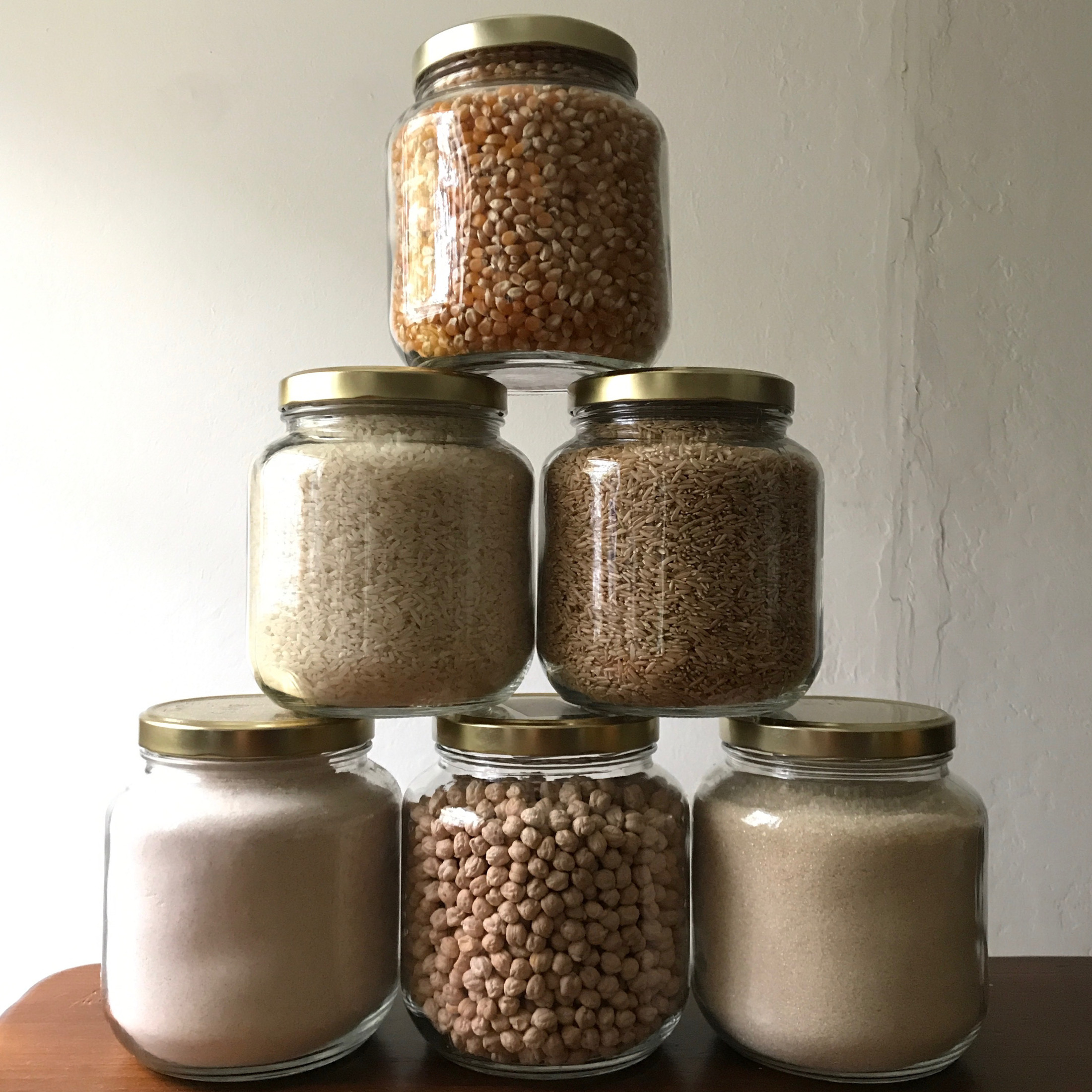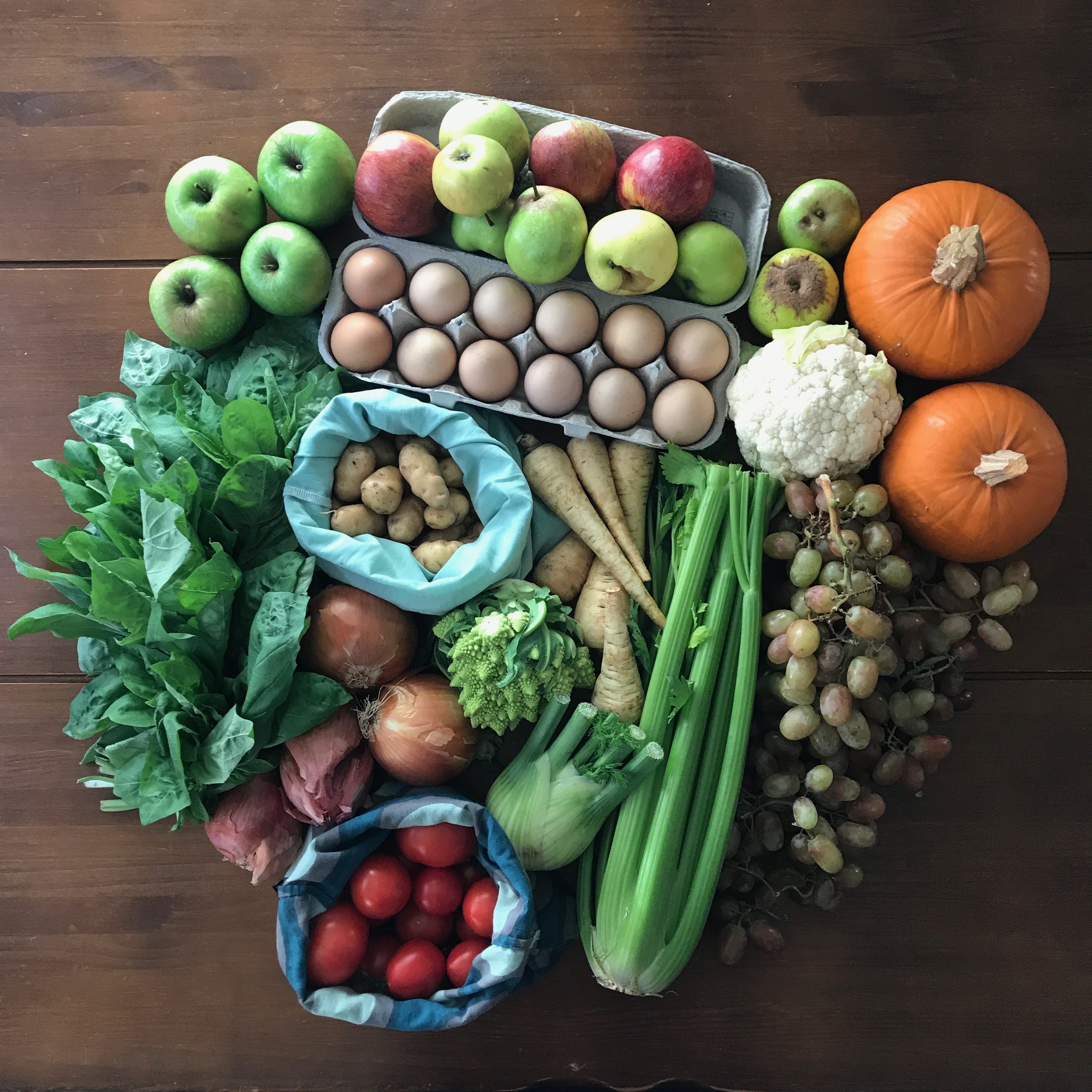This post originally appeared on the Makesmthing Week blog.
Make Your Dinner for #Makesmthng Week
Just in time for peak holiday consumption comes Make Something Week, a campaign created by Greenpeace to encourage people to create rather than passively consume.
One of the most important things you can make is your dinner. And you can do it without waste. It requires a bit of planning but not that much. I’ll use a simple recipe like pumpkin dal as an example, which I posted recently on my blog.

For this recipe you will need:
- Oil
- Red lentils
- Various spices
- Fresh produce: onions, garlic, tomatoes, whole pumpkin, jalapeño, lemon or lime
But how can you bring those ingredients home without also bringing home waste?

10 Steps to Plastic-Free and Zero-Waste Shopping
1. Bring your own cloth shopping bags
Opt for natural fibers when you choose bags. Synthetic materials shed tiny plastic fibers in the washing machine. This plastic ends up in our rivers, lakes and oceans. You can buy cloth shopping bags pretty much everywhere today.
2. Bring your own cloth produce bags
You won’t want to stuff your reusable shopping bags with plastic produce and bulk bags. I sew very simple bags. They last for years. If you don’t want to make your own bags, you can often find them at health food stores, food co-ops and online. Again, opt for natural fibers.
3. Bring your own glass jars and metal containers
Get the weight on these before you fill them up at the bulk bins. At some stores, customer service will weigh them for you and mark the tare (i.e., weight) on them. Other stores set out scales and you weigh the jars yourself. The cashier will deduct the weight of the jar from the total weight of your food when checking you out so you pay for the food only. Use these also for the deli, meat, cheese and ready-cooked food at grocery stores.
4. Make a shopping list and stick to it
With a shopping list in hand, you will avoid not only all those plastic-wrapped impulse buys at the front of the checkout, you’ll also know just how many bags, jars and containers you’ll need to take with you shopping. A little bit of planning will help you eliminate a great deal of your waste. Here’s a post on meal planning, including a fillable meal planner.
5. Shop more frequently for less food
If you can do this, you’ll waste less food because you’ll have less perishable food on hand to go bad before you can eat it.
6. Fill up at the bulk bins
Search for bulk stores worldwide at zerowastehome.com/app. Users can also submit stores not yet listed on this web-based app. Fill your reusable cloth bags, glass jars and other containers with staples like beans, rice, flour, oats, nuts, seeds, dried fruit and so on. Some bulk stores have an extensive selection that includes cleaning and personal care products and pet food.
7. Hit the farmers market
When you go plastic-free and zero-waste, you stop eating processed food—it’s almost always packaged in shiny plastic wrapping. At farmers markets however, you’ll find fresh, seasonal, local, organic produce that you can usually buy unpackaged. Find your local farmer’s market in the US through Local Harvest. In Canada, search through Farms.com.
8. Choose fresh, seasonal fruit and vegetables
The best food for you—seasonal vegetables and fruit—is also best for the environment and economy when you buy it locally. It travels fewer miles. You can find much of it unpackaged. More of your money stays in your local community.
9. Buy milk in returnable glass bottles
Several groceries stores near me carry milk from local dairies—in returnable glass. Depending on where you live, your local dairy may deliver milk in glass bottles that it later picks up—just like the old days.
10. Opt for foods lower on the food chain
Where I live, cheese almost always comes wrapped in plastic. Meat is often either wrapped in plastic or portioned out on foam trays wrapped in plastic. When you eat lower on the food chain you not only waste fewer packaging materials (beans are often easy to find in bulk) but you reduce the amount of resources that go into producing food higher on the food chain. Meat requires much more water to produce than vegetables, for example.
11. Bonus step! Don’t go insane
Once you decide to cut the waste, you will see plastic everywhere. That’s because it is everywhere. You may start to feel disheartened and hopeless and wonder what’s the point. Birds eat the stuff and die, turtles get entangled in it and die, seals become trapped in old plastic fishing nets and die, fish (which we eat) are full of it and die (when we eat them). WE’RE ALL GONNA DIE!
For me, taking action makes me feel better about this incomprehensibly huge problem. And just imagine if we all worked together on the plastic pollution problem, what a difference that would make. That’s what happens during Make Something Week—we consume less.
But don’t beat yourself up if you fall short and bring home contraband. I see lots of confessions on social media from zero-wasters feeling terribly guilty when they slip up (and have posted them myself). You can only do your best. Just keep trying. Changing your lifestyle is a challenge. However, cutting your waste is easier than most people realize.

Back to that pumpkin dal recipe…
Check your cupboards for what you already have on hand and make a list of the things you don’t. Next, gather your equipment—shopping bags, produce bags and jars—and go shopping for your dal ingredients.
- Oil. Olive oil and coconut oil can be difficult to find at some bulk stores. If you don’t have access to bulk oil, buy it in glass and reuse the bottle for something else (like homemade ginger beer).
- Red lentils. Fill up either a cloth produce and bulk bag or a jar. If you don’t have access to good bulk bins, for the lentils, opt for large packages of lentils for a lower packaging-to-food ratio.
- Various spices. Buy in bulk in your jars. If, again, you don’t have access to bulk bins, buy yours in glass jars (because remember, you’re just doing your best and not going insane).
- Fresh produce: onions, garlic, tomatoes, pumpkin, jalapeño, lemon or lime. Buy these in your cloth produce bags.
- Bring it all home in your reusable cloth shopping bags for a delicious zero-waste meal.
The cooking
- While you chop. As you chop your vegetables, save all the bits and scraps for making broth. You can make broth immediately if you have enough scraps or you can store them in the freezer until you have amassed enough to make homemade—and free—vegetable broth. Here is my vegetable broth recipe.
- Compost everything else. Food scraps should never go into landfill. Compacted in a landfill, food lacks exposure to oxygen and breaks down anaerobically, producing methane gas. Landfills emit this methane gas—a greenhouse gas much more potent than carbon dioxide—into the atmosphere. For the uninitiated, composting may seem mysterious but it’s a very simple process. In fact, you can’t prevent food from breaking down into compost. Here’s a post on composting the lazy way.


I love how organized you are 🙂 Btw, if you want to share your blog, I started a community pool: https://mzukowskiblog.wordpress.com/2017/12/05/100-followers-share-your-blog-below/
Great list of actionable steps! We are always looking for plastic-free options, but it decidedly a process, not something to be done overnight. Thanks for the encouragement! 🙂
Hi Kristine, I agree, it is definitely a journey and it evolves over time. Enjoy the process 🙂 ~ Anne Marie
such an inspiration! Looks and sounds very tasty as well!!
Hi there! Thank you for sharing. Im wondering where you shop for bulk and have done price comparisions for bulk shopping in the bay area.
Hi Rachel, I don’t get to Rainbow as often as I like, but when I’m in San Francisco I try to stop there. It’s my favorite place by far. I think the inventory turnover is very high and so the bulk stuff is very fresh. The prices are comparable to other bulk stores. I haven’t done a very scientific price comparison though. I can also find stuff at Rainbow that I can’t find in bulk near me: maple syrup, molasses, dried seaweed, coconut oil…you name it. Olive oil at my Whole Foods is very expensive and flour is inexpensive. Bulk spices at Whole Foods cost less than the packaged ones (for the most part). The bulk bins are decent and sometimes on sale (like 20% off all bulk) but now what Amazon owns Whole Foods, I don’t know what will happen to those kinds of deals. I try to shop at small, independents when I can. ~ Anne Marie
[…] read something on the Zero Waste Chef‘s blog recently that I thought was important to […]